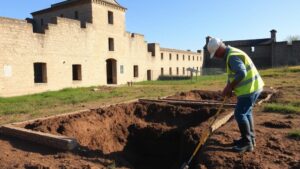Detecting Near Outdated Railroad Lines for Industrial Relics
Detecting Near Outdated Railroad Lines for Industrial Relics
In today’s rapidly evolving industrial landscape, the preservation of history through the detection of outdated railroad lines can yield invaluable insights into our past. Industrial relics offer a narrative that informs current and future transportation, urban planning, and economic strategies. This article explores the methodologies, technologies, and implications of detecting these near outdated railroad lines, emphasizing their significance in understanding industrial heritage.
The Historical Significance of Railroad Lines
Railroads have played a crucial role in shaping economies and societies since the Industrial Revolution. By facilitating the extensive movement of goods and people, they influenced urban development and industrial growth. Understanding the locations and conditions of outdated railroad lines is essential to reclaiming and interpreting this industrial heritage.
For example, the conversion of defunct rail lines into rail trails has become popularized in recent years, serving as vital community assets. According to the Rails-to-Trails Conservancy, over 24,000 miles of rail-trail projects exist in the U.S., demonstrating the enduring value of these relics.
Technological Approaches to Detection
The detection of near outdated railroad lines involves various technological approaches that aid archeologists, historians, and urban planners in identifying and analyzing these industrial remnants.
- Geographic Information Systems (GIS): GIS tools enable researchers to overlay historical maps with current geographic information, allowing for the identification of potential railroad routes that may no longer be visible.
- Remote Sensing: Aerial imagery, LiDAR, and satellite imaging can reveal subtle traces of former railroad lines. e data sets can assist in locating right-of-ways that may have been obscured by urban development.
- Ground Penetrating Radar (GPR): GPR technology provides insights into subsurface structures, helping to detect buried rail infrastructure and facilitate future excavation and conservation projects.
Case Studies of Successful Detection
Numerous projects across the globe have showcased the efficacy of these technologies. One prominent example is the revitalization of the High Line in New York City. Originally an elevated rail line built in the 1930s, it was transformed into a public park after being decommissioned in the 1980s. project relied heavily on extensive mapping and ground-penetrating assessments to preserve historical features while implementing contemporary design elements.
Another example is the use of LiDAR technology in Tasmania, Australia. Researchers combined historical data with advanced imaging to uncover the remnants of rail lines that played a crucial role in log transportation to port sites in the 19th century. This project not only identified the routes but also provided insights into the ecology and economic practices of the time.
Challenges in Detection
Despite the advancements in detection technologies, several challenges persist. One major concern is the alteration of landscapes due to urbanization. As cities expand and develop, remnants of railroad lines may be destroyed or hidden beneath new infrastructures. Also, the reliability of historical maps varies, and not all locations are well-documented.
Also, community opposition may arise during preservation efforts. Local stakeholders often seek to balance historical preservation with modern needs. Engaging communities early in the detection and interpretation processes can help mitigate these concerns, ensuring that the historical narrative is woven into contemporary development.
Conclusion: The Importance of Preservation
Detecting near outdated railroad lines is not merely an academic exercise; it is a crucial endeavor that anchors our industrial past to contemporary society. Through GIS, remote sensing, and innovative methodologies, historians and urban planners can bring to light the forgotten tracks that once propelled economic growth.
- Utilizing the aforementioned technologies can unveil hidden layers of history within urban environments.
- Maintaining an open dialogue with local communities can foster support for preservation projects.
- Understanding the historical significance of railroads reinforces the importance of integrating industrial relics into future urban planning.
As we continue to explore and document these remnants, we not only preserve our history but also create spaces that honor the legacy of industries that helped forge our modern world. approach to detecting outdated railroad lines must increasingly reflect a balance of technology, context, and community involvement.



